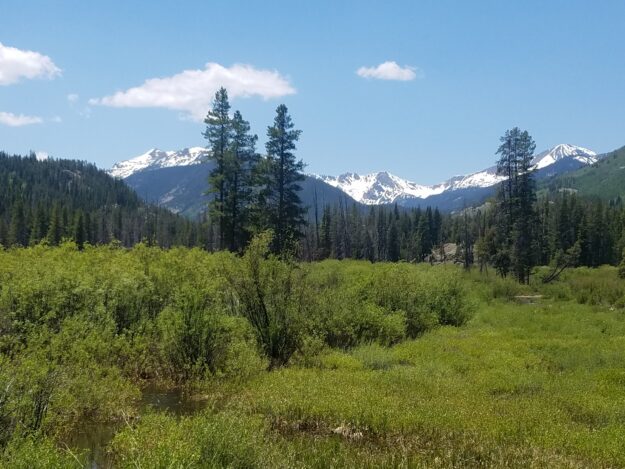Widgetized Section
Go to Admin » Appearance » Widgets » and move Gabfire Widget: Social into that MastheadOverlay zone
Hick on Western Slope water: ‘Don’t divert … unless it’s absolutely necessary’

Last month, while touring the Grizzly Creek Fire incident command center in Eagle, former Colorado Gov. John Hickenlooper talked about the impacts of human-caused climate change on a drought-stricken state that has been ravaged by its largest ever wildfires this summer and fall.
At the time, the Grizzly Creek Fire that started in Glenwood Canyon was the largest ever in the surrounding White River National Forest and the Cameron Peak Fire west of Fort Collins was the third largest in state history. In recent days, Cameron Peak has surged to the largest in state history at more than 200,000 acres, and climate change is getting a lot of the blame.

RealVail.com also checked in with Hickenlooper — a Democrat who’s leading incumbent Republican U.S. Sen. Cory Gardner in most polls in the Nov. 3 election – on the topic of transmountain diversions of water from the Western Slope drainages of the dwindling Colorado River Basin to the Front Range cities where most of the state’s people live.
The former Denver mayor, brew pub owner and oil and gas geologist said that, as much as possible, Western Slope water should stay on the Western Slope.
“When we created the Colorado Water Plan, one of the real focuses there was to make sure that we don’t divert water from one basin to another unless it’s absolutely necessary,” Hickenlooper said. “One of the things we set up in the water plan is the process by which we debate that and when people get crosswise over water, you don’t just go to a fight.”
The context of the question was a proposal by Homestake Partners, comprised of the Front Range cities of Aurora and Colorado Springs, to conduct test drilling in the Homestake Creek drainage near Red Cliff to determine the best site for a new dam for the proposed Whitney Reservoir, which would provide the cities up to 20,000 acre-feet in average annual yield.
Local towns, politicians and statewide conservation groups oppose even the test drilling, which was delayed in the U.S. Forest Service permitting process by the record wildfire season.
RealVail.com produced the following update on the Whitney Reservoir proposal for Atlantic Media’s RouteFifty.com, partially excerpted here (Hickenlooper’s statements were not included in the original version):
Climate Change Amplifies Colorado’s Water Diversion Debate
HOMESTAKE CREEK VALLEY, Colorado – Nearly 5 million people live on the eastern side of the Rocky Mountains, along what’s known as Colorado’s “Front Range,” where communities established on semi-arid prairie land need more water to keep expanding.
Now a water battle is brewing over whether the booming population centers of Aurora and Colorado Springs, with nearly 900,000 residents combined, can claim water from a remote valley on the other side of the Rockies, collect it in a new reservoir and pump it across the Continental Divide.
For many residents of bucolic Eagle County on the “Western Slope,” where Homestake Creek meanders through mountain meadows, lush wetlands and ancient fens on its way to the endangered Colorado River, it’s time to end transmountain diversions once and for all as the climate warms and drought intensifies.
But officials in Aurora, a Denver suburb, and Colorado Springs, argue they can collect the water in a new reservoir and make use of it without drastically disturbing the surrounding wilderness. More to the point: they’ve owned the rights to 20,000 acre-feet of average annual yield since 1952 and say it’s time to start exploring if they can use it—for drinking water and on suburban lawns.

“Because water is the lifeblood and it’s so important, we have been doing a relatively good job of having collaborative conversations that are getting us to a point, but the issue is growth and climate change are both happening now so fast and historically these collaborative conversations take a really long time,” said Eagle County Commissioner Matt Scherr.
“Are we going to be able to address that at the scale and speed that the problem is moving?” Scherr added. “So, you hate to see this end up being essentially a war for water, but if we don’t figure out how to do it in a holistic way, that could be our future.”
To read the full story, please go to RouteFifty.com.
David O. Williams
Latest posts by David O. Williams (see all)
- Neguse, Bennet call for halt to BLM emergency rule aimed at increasing Utah oil-train traffic - June 23, 2025
- The O. Zone: Trump’s long list of broken campaign promises just jumped to yet another forever war - June 23, 2025
- The O. Zone: Coming to Vail this summer? Leave fireworks, risky fire behavior at home - June 20, 2025



Mark Richardson
October 25, 2020 at 1:49 am
From the Route 50 piece:
[Quote] One acre-foot of water serves a family of four for one year, according to the U.S. Bureau of Reclamation [End quote]
The statement above is questionable. One acre-foot of water is 325,851 gallons of water. Since 2000 the residents of Metro-Denver have reduced their household water use by about half, from 175 gallons daily down to 90 gallons daily. Now 90 gallons daily x 365 is 32,850, so one acre-foot supplies the household use of almost 10 people in Metro-Denver on an annual basis.
There are areas of the US where household water use is much more than 90 gallons per-person per-day and other areas where it is less. Recently both Las Vegas and El Paso residents have been getting-by on just 75 gallons of household use daily per-person. Residents of Juarez, Mexico get by on just 50 gallons daily and residents of Mexico City just 40 gallons daily, but Mexico allows rain-barrels to draw from rooftops too.
Now here is another problem with how water use is counted. Food production. Let’s say that average crop yield is 12,000 lbs. per-acre and that it takes 3 acre-feet to grow a crop. Now including the current total loss rate of 50.3% of all food produced between the farm and end user, to produce a 2000-calorie average daily diet per-person 1913 lbs. of food must be grown to produce 951 lbs. of consumption annually. What is 12,000 divided by 1913? Just over 6. What is one million divided by 6? 166,667. What is that divided by 365? That is another 456.62 gallons of water per-day per-person.
What about power plant cooling or fracking? A chart I have here shows an average of 12 million gallons is required to frack the average horizontal oil & gas well in Colorado. What kind of heat and hot water heater do you have? Where do you get your electric power from? Rooftop solar like my wife and I or from Xcel, who has to use tens of millions of gallons of water daily to cool each unit in their power plants. Refining oil into gasoline, diesel fuel, and jet fuel requires a fair amount of water too. Do you drive a vehicle that gets lousy fuel mileage? You use more water doing that too.
Do you play golf? In Palm Springs the average golf course goes through over one million gallons of water daily just to keep the grass green. What about snowmaking? At-least most of the snow made in Colorado ends-up back in rivers later, except that lost to evaporation. A lot of the water dumped on golf courses evaporates too as does water dumped on farms and lawns.
There is a darn good study I have been reading now for a couple of years on urban water use. It was a doctoral dissertation at the University of Utah. It was new in 2016. Philip Stoker is the author. The findings suggest that urban water use can be cut substantially by reducing lot size, enough that cities can continue to grow using less water per-household than had been the case previously. The author goes to a lot of trouble to prove his point. Imagine dropping household use from 90 gallons per-person daily to only 50 gallons just by cutting lot size?
But what about the water used to grow food, cool power plants, frack with, refine oil into fuel with, water golf courses with, and make snow with? The fact is that we really can’t keep growing our population even if urban lot sizes fall substantially, as each new person needs lots more water for food than is saved reducing lot size, and as our temperature continues to rise so will our evaporation rate, which will increase the amount of water needed to keep the grass green and the amount of snow we need to make too.
Back in 2014 I discovered that the surface evaporation rate at high-altitude reservoirs was a small fraction of the evaporation rate at Lake Mead. For instance the evaporation rate at Twin Lakes Reservoir south of Leadville is only 30% that of Lake Mead. A peer-reviewed Australian study also found that if water was pulsed downriver at-least once per-week that would be enough to maintain the riverine ecosystem.
If we want to save a whole lot of water why not keep all the lower basin water in high-altitude reservoirs and then pulse it downriver as-needed? Doing this would save about 1 million acre-feet per-year lost to evaporation out of Lake Mead. If the average lower basin resident can be held to just 90 gallons of household use daily that would enough savings to supply the annual household use of almost 10 million people.
Of course downstream water users would have to build a substantial pumping and tank storage capacity large enough to maintain supply between pulses. If we could save one million acre-feet annually that might be enough to allow the Front Range a little more water, especially if daily use can be further reduced some.
Someday soon growth will have to end though unless we either increase crop yield substantially, eat a lot less food, eat a lot less meat, eat a lot less chocolate, drive a lot more EVs or quit driving so much, quit flying as much as we do, quit wasting so much water keeping grass green, quit fracking, and use a lot more solar and wind power so that we don’t have to cool power plants nearly as much as we do today. Working from home would help too.
Just think, if Front Range per-person daily water use could be reduced from 90 gallons daily to just 80 gallons daily that would save enough water to supply the annual household use of 1 more person per-acre-foot. That would be 10% growth.
You want to save some water pretty easily? Get two 5-gallon plastic buckets and put them in the shower and then turn the water on. At-first the water will be cold and most of us will wait for it to warm up. By the time it warms-up there will be a gallon or more of clean water in each bucket. Then take your shower.
After you shower there will be 2-3 gallons of diluted wastewater in each bucket, which you can use to flush your toilet or even use to water plants. If you shower every day this will save 4-6 gallons daily per-person. Now you are down to just 84-86 gallons of water use daily per-person.
So one-acre foot of water can supply a lot more household use than just that of 4 people, and frankly if our temperature keeps rising we must figure-out how to greatly-reduce water-use no matter what it is used for.
How about discontinuing both low-yield and high water-use crops? We all love Bell peppers but average yield is only 5000 lbs./acre. How about using Anaheim peppers instead as their yield is higher? How about cutting down consumption of beef? It takes 2500 gallons of water to produce one pound of beef. How about cutting way down on chocolate too as it used a lot of water to produce also? Almonds too for that matter. Corn too. Eat more broccoli and cauliflower.
I am afraid that all of us anywhere near Colorado are going to have to figure-out how to reduce our water use no matter what side of the Continental Divide we live on. This means you too.